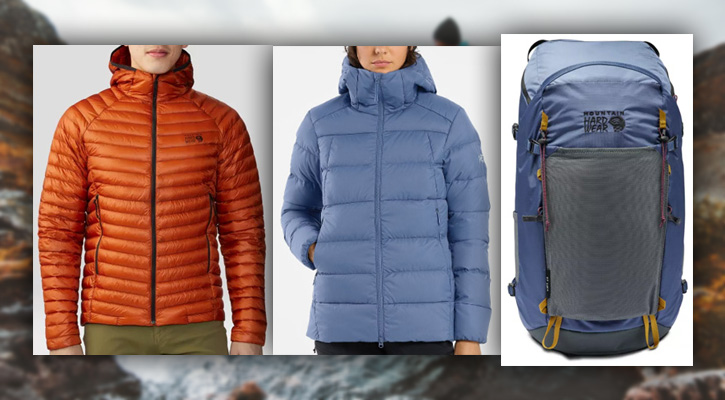
Mountain Hardwear and Arc’teryx have a strong heritage in the outdoor industry, both being born from a passion for mountaineering and climbing.
Each company brings its unique approach to design, materials, and technology, aiming to enhance the experiences of hikers, climbers, and adventurers alike.
In this article, we go through their histories, products, and philosophies, to help you make the right choice for your outdoor gear.
Whether you prioritize innovative materials, ethical production, or a balance between price and performance, this comparison will explore what sets these two iconic brands apart.
Let’s get started!
Contents:
1. Mountain Hardwear Outdoor Gear
History of the Brand
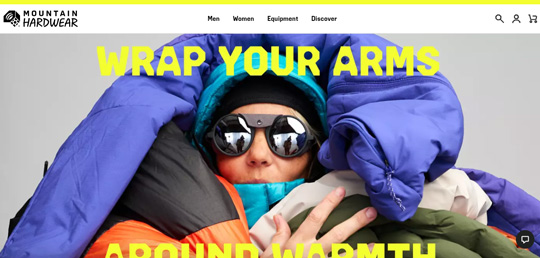
Mountain Hardwear’s official website
The Mountain Hardwear label originated in California, USA, in 1993, from a team previously associated with the Sierra Designs company. Ed Viesturs, the first American to conquer fourteen 8,000-meter peaks, notably contributed to the brand’s early triumphs and later became a sponsor.
This association with accomplished mountaineers and their expeditions has been very important for the company’s popularity.
In 2003, Columbia Sportswear acquired the Mountain Hardwear brand, marking a significant milestone. The inaugural Mountain Hardwear retail store was established in Portland, Oregon in 2008, followed by another in Seattle, signaling the brand’s ongoing expansion.
Don’t miss: 8 Brands like Mountain Hardwear: Our Best Alternatives
Materials, Fabrics, and Production Process
Mountain Hardwear is renowned for its premium materials and cutting-edge manufacturing methods, enabling its products to surpass expectations. Their apparel ensures outstanding performance for outdoor enthusiasts and athletes.
The mountaineering apparel offers exceptional resistance and protection against low temperatures, boasting superb thermal insulation. The brand consistently updates its production, enhancing its designs to optimize athletes’ experience.
The parkas, jackets, and other clothing feature natural down insulation, wool, and flannel fabrics, providing warmth even in the most frigid conditions. Additionally, some of their jackets use fleece, a soft material akin to sheep’s wool, offering warmth and comfort on the skin.
These materials are robust and enduring, regulate body temperature, shield from the wind, and incorporate advanced technology. Mountain Hardwear incorporates various fabric technologies such as Pertex Y Fuse, various options of Gore-Tex, Dyneema Composite fabrics, and more.
When it comes to synthetic insulation, PrimaLoft and Polartec fleece are key components for warmth in their products. The brand also uses the RECCO® technology, an advanced rescue system, in some of its gear. Sustainability is an important point guiding the company’s production processes and ethical business practices.
The video will be loaded from YouTube.com, a third party. If you play it, you accept their terms of service, and their use of cookies.
Read also: Mountain Hardwear vs Columbia: Which Brand is Better?
Where is Mountain Hardwear outdoor gear made?
Mountain Hardwear’s outdoor equipment (together with other Columbia-owned labels) is predominantly manufactured in Asia, in countries like China, Bangladesh, India, and Vietnam. (source)
Recommended Products
Mountain Hardwear Men’s Ghost Whisperer/2 Hoody
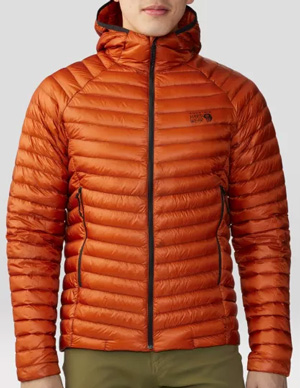
Image: mountainhardwear.com
Check it out at MountainHardwear.com
The Men’s Ghost Whisperer/2 Hoody by Mountain Hardwear is a lightweight down jacket suitable for various outdoor adventures. Crafted from 100% recycled nylon and filled with 800-fill RDS-certified down, it provides optimal warmth.
This jacket offers a standard fit for unrestricted movement and incorporates practical features such as synthetic insulation at the cuffs, an adjustable hood, and zippered hand pockets. It can be compacted into its own pocket, enhancing its travel-friendly nature.
Weighing around 8.8 ounces (249 g) for a medium size, this hoody is both insulating and lightweight, boasting a center-back length of 27.5 inches (69.9 cm). It presents a sustainable option for outdoor enthusiasts to minimize their environmental footprint while enjoying comfort in nature.
Read also: Mountain Hardwear vs The North Face: Which is Better?
Mountain Hardwear Women’s JMT 25L Backpack
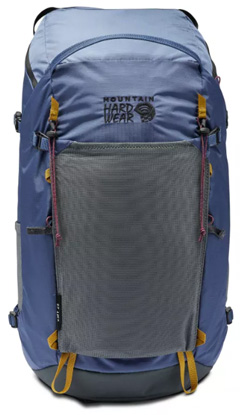
Image: mountainhardwear.com
Check it out at MountainHardwear.com
The Women’s JMT 25L Backpack from Mountain Hardwear is a sturdy and lightweight daypack tailored for outdoor pursuits like hiking and climbing. Made of a durable 500D CORDURA® base, it is engineered for longevity. This backpack is equipped with a women-specific fit, a ventilated back panel, and padded shoulder straps to ensure comfortable transport.
Its opening allows for effortless gear access, and it incorporates a zippered top pocket for efficient organization. Side compression straps aid in securing the load, while attachment loops are provided for hiking poles or an ice axe.
With its modern design and essential features, the JMT 25L offers a practical option for day hikers who need a blend of performance and comfort.
Don’t miss: Mountain Hardwear vs Patagonia (Outdoor Gear Comparison)
Prices
Mountain Hardwear is usually considered a mid-to-high-end brand, with jackets ranging from $100 to $1,000 for specialized high-performance styles, and backpacks priced between $90 for daypacks and $450 for alpine packs.
Are Mountain Hardwear products worth the price?
We love the designs of this brand, and based on online reviews, it’s widely agreed that their products are durable, practical, and offer excellent comfort. So, yes, this is a brand worth investing in!
Must read: 8 Best Sustainable Outdoor Clothing Brands: Our Top Picks
2. Arc’teryx Outdoor Gear
History of the Brand
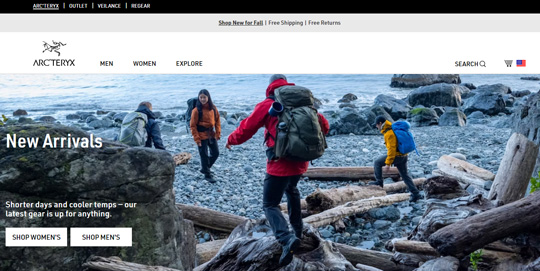
Arc’teryx official website
Founded in 1989 by Dave Lane, Arc’teryx is a renowned Canadian brand that specializes in outdoor apparel and gear, famous all over the world. Initially known as Rock Solid, the company focused on crafting climbing equipment.
In 1991, Dave Lane collaborated with Blair Murdoch and Tim Duholke, leading to the establishment of the official name Arc’teryx. The brand’s name is linked to the Archaeopteryx, the earliest known bird, representing progress and creativity.
Arc’teryx has introduced many iconic products in the outdoor market, such as the Bora backpack and the Vapor harness. Upon obtaining the license for Gore-Tex fabrics, the company broadened its product line to encompass outdoor clothing. Arc’teryx continues to incorporate Gore-Tex fabrics into many of its top-performing jackets.
While the brand initially concentrated on climbing gear, it now serves hikers, climbers, and snowsport enthusiasts, offering premium snowsport and outdoor wear in the market.
Don’t miss:
9 Outdoor Brands like Arc’teryx: Our Favorites
Marmot vs Arc’teryx (Outdoor Gear Comparison)
Materials, Fabrics, and Production Process
Arc’teryx is celebrated for its utilization of premium, sustainable, and responsibly sourced materials. These materials carry Bluesign® certification and undergo thorough evaluation via Arc’teryx’s Life Cycle Assessment protocols to assess the impact of the product life stages.
The Canadian company employs a mix of natural and synthetic materials, tailored to the type of design, to guarantee the superior quality of all products.
The natural down insulation in their jackets adheres to the Responsible Down Standard, ensuring the ethical treatment of ducks and geese. The brand mostly uses Coreloft for synthetic insulation blends and Gore-Tex for its membranes and fabric technologies in its apparel. For backpacks, Arc’teryx employs its proprietary AC2 technology.
The company places a strong emphasis on ethical manufacturing and sourcing of materials, a key factor in its increasing popularity.
The video will be loaded from YouTube.com, a third party. If you play it, you accept their terms of service, and their use of cookies.
Read also:
Is Arc’teryx Sustainable? A Look at their Environmental Practices
Eddie Bauer vs Arc’teryx (Outdoor Gear Comparison)
Where is Arc’teryx outdoor gear made?
Arc’teryx produces in many countries worldwide, including Canada. The Canadian factory, called ARC’One, is located in Vancouver, BC, and is responsible for 10% of the brand’s apparel and gear.
The majority of Arc’teryx gear though (90%) is made in Asia, in places such as China, Vietnam, Indonesia, Bangladesh, Philippines, etc., but also in Romania and El Salvador. (source)
Recommended Products
Arc’teryx Women’s Thorium Hoody
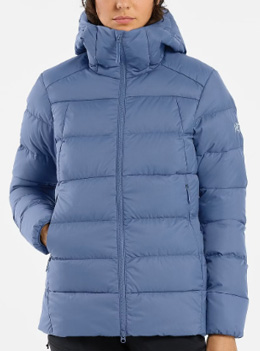
Image: arcteryx.com
Check it out at Arcteryx.com
The Arc’teryx Women’s Thorium Hoody is a dependable and adaptable jacket, perfect for chilly, arid weather. It delivers outstanding insulation and protection for various climates.
This jacket is packed with 750-fill-power RDS-certified grey goose down, which offers superior heat retention relative to its mass. Utilizing Down Composite Mapping™, the design smartly allocates Coreloft™ synthetic fill in moisture-prone regions, providing enhanced defense against weather conditions.
Constructed with a robust yet lightweight Arato™ 30 nylon exterior, the hoody is finished with a DWR treatment to repel water. The interior liner is crafted from a bio-based fabric, contributing to a reduction in petroleum dependency. The hoody also boasts an insulated hood that adjusts to comfortably accommodate a helmet, offering additional protection.
Don’t miss: The North Face vs Arc’teryx: Which Brand is Better?
Arc’teryx Bora 65 Backpack for Men
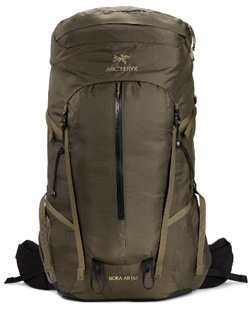
Image: arcteryx.com
Check it out at Arcteryx.com
The Bora 65 Men’s Backpack is an ideal choice for outdoor enthusiasts preparing for a weekend or extended trip. It boasts a comfortable carry that facilitates exploration and pushing your boundaries. The RotoGlide™ hipbelt adapts to body movements, enhancing balance and stability.
With GridLock™ harness adjustability, it ensures a precise fit. Crafted from Cordura® pack cloth, the backpack is robust for backcountry use. The lid incorporates a Weather Vault for waterproof storage, while the main compartment is easily accessible from the top or side, complemented by multiple external pockets.
This backpack provides a dependable solution for those outdoor enthusiasts who want a comfortable and functional option for prolonged backcountry excursions.
Read next: Arc’teryx vs Columbia: Which Brand is Better?
Prices
Arc’teryx is known as a high-priced label in general in the outdoor community, featuring jackets priced from $150 to $1,000 and backpacks from $50 to $350.
Are Arc’teryx products worth the price?
Despite the expensive prices, Arc’teryx items, in our opinion, justify the expense by delivering exceptional performance and longevity. So, Arc’teryx equipment is a worthy investment for those who are dedicated to mountain activities or winter sports.
Although the prices may be a deterrent for certain consumers, this brand’s products’ quality and performance are worth investing in.
Learn more: Why is Arc’teryx so Expensive and Popular? Is It Worth It?
3. Which Brand is Better? Mountain Hardwear or Arc’teryx?
These are two of the highest-quality brands for mountain activities! But you have to pick one, so, here are our thoughts:
- Although the prices are similar, Mountain Hardwear is more affordable on average, while Arc’teryx is premium-priced. Arc’teryx products are generally known as using more advanced materials and construction.
- Mountain Hardwear focuses more on layering systems and basics for mountaineering, climbing, and hiking. Arc’teryx also has gear for those activities but has a wider range including lifestyle and everyday apparel.
- Mountain Hardwear has a wide selection of tents and sleeping bags. Arc’teryx is not known for these types of products, but it offers footwear which Mountain Hardwear does not.
- Arc’teryx is seen as having a bit more stylish designs and fits. Mountain Hardwear has improved in this regard but still skews more technical.
- For weather protection and shells, Arc’teryx’s Gore-Tex products are top-tier while Mountain Hardwear uses a mix of membranes.
- Both have advanced sustainability programs focused on using recycled and ethical materials.
So, in the end, if your budget is limited, we’d look at Mountain Hardwear first. If you want leading-edge materials and performance with less regard to price, Arc’teryx is hard to beat in the current outdoor market. Trying products on can help you understand which brand is the right one for you.
Read next: 9 High-End, Expensive Hiking Brands for Clothing and Footwear
